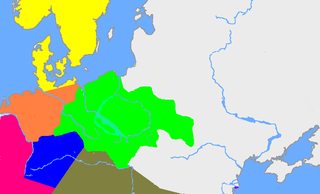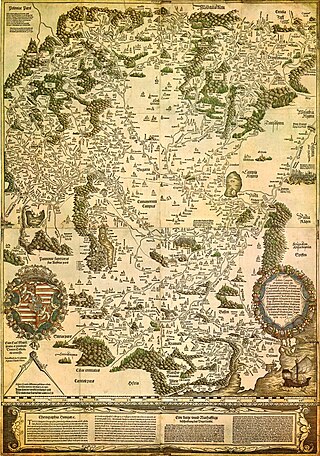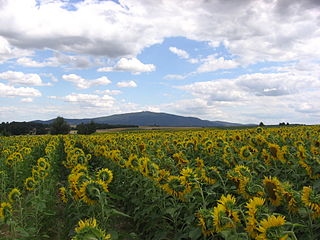
The Lusatian culture existed in the later Bronze Age and early Iron Age in most of what is now Poland and parts of the Czech Republic, Slovakia, eastern Germany and western Ukraine. It covers the Periods Montelius III to V of the Northern European chronological scheme. It has been associated or closely linked with the Nordic Bronze Age. Hallstatt influences can also be seen particularly in ornaments and weapons.

The Jastorf culture was an Iron Age material culture in what is now northern Germany and southern Scandinavia spanning the 6th to 1st centuries BC, forming part of the Pre-Roman Iron Age and associating with Germanic peoples. The culture evolved out of the Nordic Bronze Age.

The area known as Croatia today has been inhabited throughout the prehistoric period, ever since the Stone Age, up to the Migrations Period and the arrival of the White Croats.

The history of Hungarybefore the Hungarian conquest spans the time period before the Hungarian conquest in the 9th century of the territories that would become the Principality of Hungary and the Kingdom of Hungary.

The Przeworsk culture was an Iron Age material culture in the region of what is now Poland, that dates from the 3rd century BC to the 5th century AD. It takes its name from the town Przeworsk, near the village where the first artifacts were identified.

Prehistoric Europe refers to Europe at a stage populated by humans but before the start of recorded history, beginning in the Lower Paleolithic. As history progresses, considerable regional unevenness in cultural development emerges and grows. The region of the eastern Mediterranean is, due to its geographic proximity, greatly influenced and inspired by the classical Middle Eastern civilizations, and adopts and develops the earliest systems of communal organization and writing. The Histories of Herodotus is the oldest known European text that seeks to systematically record traditions, public affairs and notable events.

The Ślęża is a 718 m (2,356 ft) high mountain in the Sudeten Foreland in Poland. The mountain is built mostly of granite and is covered with forests.
The archaeology of Northern Europe studies the prehistory of Scandinavia and the adjacent North European Plain, roughly corresponding to the territories of modern Sweden, Norway, Denmark, northern Germany, Poland and the Netherlands.

Prehistoric Wales in terms of human settlements covers the period from about 230,000 years ago, the date attributed to the earliest human remains found in what is now Wales, to the year AD 48 when the Roman army began a military campaign against one of the Welsh tribes. Traditionally, historians have believed that successive waves of immigrants brought different cultures into the area, largely replacing the previous inhabitants, with the last wave of immigrants being the Celts. However, studies of population genetics now suggest that this may not be true, and that immigration was on a smaller scale.

Prehistoric France is the period in the human occupation of the geographical area covered by present-day France which extended through prehistory and ended in the Iron Age with the Roman conquest, when the territory enters the domain of written history.

The Stone Age in the territory of present-day Poland is divided into the Paleolithic, Mesolithic, and Neolithic eras. The Paleolithic extended from about 500,000 BCE to 8000 BCE. The Paleolithic is subdivided into periods, the Lower Paleolithic, 500,000 to 350,000 BCE, the Middle Paleolithic, 350,000 to 40,000 BCE, the Upper Paleolithic, 40,000 to 10,000 BCE, and the Final Paleolithic, 10,000 to 8000 BCE. The Mesolithic lasted from 8000 to 5500 BCE, and the Neolithic from 5500 to 2300 BCE. The Neolithic is subdivided into the Neolithic proper, 5500 to 2900 BCE, and the Copper Age, 2900 to 2300 BCE.

The Bronze and Iron Age cultures in Poland are known mainly from archeological research. Early Bronze Age cultures in Poland began around 2400–2300 BCE, while the Iron Age commenced in approximately 750–700 BCE. The Iron Age archeological cultures no longer existed by the start of the Common Era. The subject of the ethnicity and linguistic affiliation of the groups living in Central Europe at that time is, given the absence of written records, speculative, and accordingly there is considerable disagreement. In Poland the Lusatian culture, spanning both the Bronze and Iron Ages, became particularly prominent. The most famous archeological finding from that period is the Biskupin fortified settlement (gord) on the lake from which it takes its name, representing the Lusatian culture of the early Iron Age.

Poland in antiquity was characterized by peoples from various archeological cultures living in and migrating through various parts of what is now Poland, from about 400 BC to 450–500 AD. These people are identified as Slavs, Celts, Germanic peoples, Balts, Thracians, Avars, and Scythians. Other groups, difficult to identify, were most likely also present, as the ethnic composition of archeological cultures is often poorly recognized. While lacking any written language to speak of, many of them developed a relatively advanced material culture and social organization, as evidenced by the archeological record; for example, richly furnished, "princely" dynastic graves.

The most important phenomenon that took place within the lands of Poland in the Early Middle Ages, as well as other parts of Central Europe was the arrival and permanent settlement of the West Slavic or Lechitic peoples. The Slavic migrations to the area of contemporary Poland started in the second half of the 5th century AD, about a half century after these territories were vacated by Germanic tribes fleeing from the Huns. The first waves of the incoming Slavs settled the vicinity of the upper Vistula River and elsewhere in the lands of present southeastern Poland and southern Masovia. Coming from the east, from the upper and middle regions of the Dnieper River, the immigrants would have had come primarily from the western branch of the early Slavs known as Sclaveni, and since their arrival are classified as West Slavs and Lechites, who are the closest ancestors of Poles.
The prehistory of Southeastern Europe, defined roughly as the territory of the wider Southeast Europe covers the period from the Upper Paleolithic, beginning with the presence of Homo sapiens in the area some 44,000 years ago, until the appearance of the first written records in Classical Antiquity, in Greece as early as the 8th century BC.

After the glaciers of the Ice Age in the Early Stone Age withdrew from the area, which since about 1000 AD is called Pomerania, in what are now northern Germany and Poland, they left a tundra. First humans appeared, hunting reindeer in the summer. A climate change in 8000 BC allowed hunters and foragers of the Ertebølle-Ellerbek culture to continuously inhabit the area. These people became influenced by farmers of the Linear Pottery culture who settled in southern Pomerania. The hunters of the Ertebølle-Ellerbek culture became farmers of the Funnelbeaker culture in 3000 BC. The Havelland culture dominated in the Uckermark from 2500 to 2000 BC. In 2400 BC, the Corded Ware culture reached Pomerania and introduced the domestic horse. Both Linear Pottery and Corded Ware culture have been associated with Indo-Europeans. Except for Western Pomerania, the Funnelbeaker culture was replaced by the Globular Amphora culture a thousand years later.
The area today known as Slovakia has been inhabited throughout the prehistoric period.
Prehistoric technology is technology that predates recorded history. History is the study of the past using written records. Anything prior to the first written accounts of history is prehistoric, including earlier technologies. About 2.5 million years before writing was developed, technology began with the earliest hominids who used stone tools, which they first used to hunt food, and later to cook.

The prehistory of the Netherlands was heavily influenced by the region's constantly changing, low-lying geography. Inhabited by humans for at least 37,000 years, the landscape underwent significant transformations, from the last ice age's tundra climate to the emergence of various Paleolithic groups. The region witnessed the development of the Swifterbant culture, which was closely linked to rivers and open water, while the Mesolithic era saw the creation of the world's oldest recovered canoe, the Pesse canoe. The arrival of agriculture around 5000–4000 BC marked the beginning of the Linear Pottery culture, which gradually transformed prehistoric communities.
Stone Age in Azerbaijan is divided into the Paleolithic, Mesolithic, and Neolithic periods. It was studied in Karabakh, Gazakh, Lerik, Gobustan, and Nakhchivan. Stone materials belonging to the Stone Age were found by Mammadali Huseynov in the Shorsu gorge located near the village of Gyrag Kasaman in Qazakh region. According to his research, people have first settled in the territory of Azerbaijan 2 million years ago. The Stone Age era involved two different human species: Homo neanderthalensis and Homo sapiens.













